Abstract
This article presents part of the results of the restoration of a house within the walls of the ancient city of Monopoli in Puglia, Italy. The aim is to propose a methodological approach for the conservation of minor assets of ancient centers that are aimed at recognizing, on the one hand, the historical and cultural value of the asset and, on the other, the seismic vulnerability of the artefacts, which is a key topical problem for the conservation of historic cities. A brief introduction on the context of belonging, which is characterized by similar cases, precedes the following preliminary investigations: a historiographical investigation on the urban landscape; then, a critical inquiry and related essays. Preliminary investigations have rendered it possible to highlight: on the one hand, the phases in respect of the transformation of the building in question (i.e., 3rd century BC–19th century AD); and on the other hand, to identify a 15th century gunboat and an underground room that is characterized by ancient walls. The data, acquired in the cognitive phase and confirmed by the essays, determined the project. In other words “knowledge for the restoration of artefacts” was achieved. The project is aimed at reversibility, recognition and compatibility. Furthermore, it provides for the recovery and enhancement of the underground environment with horizontal structures and connections between the two levels that will possess reversibility criteria through the use of dry technologies. The restoration site started with the excavation of the base, which was a very complex process from an operational point of view. Moreover, on the one hand, such a process highlighted the hidden structures of the ancient city. On the other hand, it has highlighted an important criticality in relation to the foundation system, which is closely linked to the process evolution of the manufactured article. The restoration site of the external walls, carried out with sustainable techniques and materials, has brought to light this ancient fifteenth-century gunboat.
1. Introduction
Historical buildings, in general, are characterized by assets that are subject to direct protection [1]. However, the theme regarding the protection of ancient centers in Italy remains extremely heterogeneous today. There are no general intervention guidelines, especially for minor and widespread historic buildings [2]. In this general framework, the contribution to its development tends to promote a design approach for the reuse and enhancement of minor buildings in multilayered urban contexts. Often, this starts from the definition of the ancient center as defined by Roberto Pane [3]. In relation to this definition, the ancient center corresponds to the sphere of archaeological stratification, as well as to the primitive nucleus. Further, the definition encompasses its origins within the medieval, Renaissance, Baroque and nineteenth-century structures and forms that were configured within successive stratifications. Minor buildings, therefore, that are similar to monuments need to be studied, as well as observed through preparatory investigations for purposes of their conservation. The house in Largo Castello di Monopoli fits right into the set of stratified buildings. The house, before the interventions, had three rooms leaning against the city walls. The latter, emptied in the central part, were intended for service rooms overlooking the seafront. The external elevation concludes the sea front of the port with a masonry facade cut by a long concrete balcony. The transformations of the house are consistent with what happened in the nineteenth century in respect of numerous Italian urban landscapes [4] where, following the end of their defensive functions, the walls were perceived as a limit to urban development. The houses have generally taken the place of the ancient city walls, thereby redesigning the skylines with different views every time. Conversely, however, as in this case study, they have also leaned against each other, thereby digging out their imposing thicknesses in order to create other rooms. As such, these are examples of evolutionary transformations [5] that, depending on the cultural area to which they belong, have been characterized by their own technical-constructive peculiarities from which they derive both the overall configurations of the building organism, as well as the critical points of degradation and instability [6]. In respect of the coastal urban landscapes of Puglia, the city walls have been deconstructed not only to create livable spaces, but also to counteract marine aerosol degradation [7]. The studies carried out in this restoration intervention have made it possible to highlight the evolutionary transformations and constructive criticalities that are of great interest for the study of the ancient city’s fabric (Figure 1).

Figure 1.
(a) View of the house from the sea and (b) view of the old port.
2. Methodology
In this study, the aim is to outline a methodological path for the protection, conservation and enhancement of minor artefacts in historical centers. The approach is based on studies that are aimed at recognizing the historical and cultural value of the property, as well as to contextually understand the seismic vulnerability of the building. The methodological path was to acquire as much data as possible on the history of the transformations of the building, which—only through the intersection of restoration methods, methods of architectural archeology and landscape archeology—can, with field research practices, determine a framework that is exhaustive enough to accommodate and contextually suggest techniques for the purposes of a sustainable restoration. The construction site of knowledge, which was launched well in advance of the restoration site, also follows in line with the construction site phases. Documentary-based historical studies have been carried out on the boundary walls and on their transformation phases. This has, therefore, rendered it possible to document the transformations of the house within the walls over time. Various types of tools were used in this phase, such as iconographic sources, historical projects, historical-archaeological investigations and archival photographic sources. Subsequently, the studio dedicated itself to the critical survey of the proposed building as a cognitive investigation tool, as well as a fundamental basis for the exercise of critical and interpretative activities that are related to the stratification and transformation of the building (i.e., architectural, stratigraphic, typological and three-dimensional morphological investigations). The test campaign confirmed the data acquired from previous investigations. The restoration project arises from the level of knowledge by providing for interventions aimed at reversibility, compatibility and recognizability. The chosen design line, verified with the technicians of the protection institution and with the owners, was to leave visible, where possible, the greatest number of historical testimonies in order to provide value and visibility to the “historical documents of the city”. The restoration site, which is complex and articulated, has seen various phases to date: the phase of demolition in respect of the incoherent material; the excavation phase for the recovery of the underground environment and for the recognition of the structural criticality of the foundations; as well as the phase of the conservative recovery of the external walls and the restoration of the gunboat.
3. Surveys on the Historic Urban Landscape
The urban area in which the house is located corresponds to the ancient “peninsula” of Punta Penne di Monopoli, which is the urban area of the medieval city. In general, the Apulian coastal peninsulas, which are created by the ancient outflow of water from erosive alluvial furrows (i.e., blades), have been protected by defensive scaffolding since the Bronze Age. In the Middle Ages, between the 10th and 13th centuries, the major peninsulas became fortified coastal cities [8]. This is the case in respect of Monopoli, Mola di Bari, Bari, Giovinazzo, Biceglie, Molfetta and Trani all along the Adriatic coast. The studies carried out by the Archaeological Superintendence [9] in the oldest area of the city have documented a settlement of huts from the pre-protohistoric age equipped with a defensive structure. The protohistoric village extended up to the most advanced promontory, which was called a “pinna” in the Middle Ages from which the church of San Nicola in Pinna took its name. The village dates back to the end of the 10th century and was incorporated into the castle adjacent to the house. Certain historical-documentary studies have included hypotheses regarding the fact that the walls of the modern age, as commissioned by the viceroy Pedro De Toledo in the 16th century [10], overlapped the previous walls (which were of Lombard–Byzantine construction from the 7th century; Byzantine from the 10th century and Norman from the second half of the 11th century) [11]. The excavations carried out during the restoration of the castle and the sixteenth-century walls confirmed the settlement continuity of the site. In the basement of the castle, structures from the Roman era were found together with the remains of the medieval church of San Pietro della Pinna from the 10th century—from which the ancient city center took its name. Stone blocks that are attributable to a fortification of the Messapic age [12] were found under the sixteenth-century walls. The castle, built at the same time as the walls (i.e., 1544–1552) was documented by the iconography of the second half of the sixteenth century (1579–1580) and became a residence in 1660. Then, the moat was transformed into a garden [13]. Regarding the study of the iconographic documents, one can observe that the area occupied by the house in question corresponds to the historic garden of the castle. In 1832, the castle was transformed into a prison with new alterations. The works of the port and the Margherita pier refer to this historical period (i.e., 1811–1866), which modified the dimensions of the external spaces of the castle [14]. From the superimposition of our house with the port project, it can be seen that a wall parallel to the entrance to the castle, i.e., referring to its garden, is incorporated into the house (Figure 2(b1)). It must be noted that between the 19–20th centuries, the castle was abandoned. Investigations have indicated that the site was affected by the: (1) pre-protohistoric defense walls (during the Bronze Age); (2) walls of the Messapic age (also documented by the excavation inside the house); (3) defensive walls of a later period replaced in the modern age by sixteenth-century walls; (4) garden walls of the eighteenth-century castle close to the sixteenth-century wall; (5) construction of the house, which can be attributed to the period between 1811–1866, which is when the port and the Margherita quay were built and the change in road heights took place (Figure 2(b2)). Furthermore, in this time, the filling to create vaulted rooms in adherence to the ancient wall of the sixteenth century was favored. Moreover, it was excavated in its central part for the purposes of the sea view in respect of the service areas.
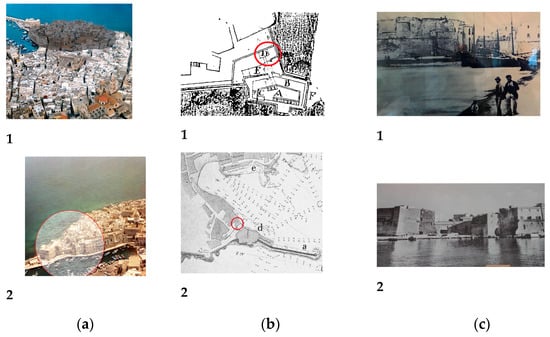
Figure 2.
(a1). The aerial view of the peninsula of Punta Penne and (a2). The location of the study area. (b1). Plan of the Castillo de Monopoli (Maplas, Planos y Dibujos, XIX-4, Archivio General de Simancas, 1580) and (b2). the Port project (Ing. Lamberti, 1866). (c1,c2) The historical photos of the house (Brigida Monopoli photographic archive).
4. Critical Drawings
The house is characterized by six rooms on the ground floor and one in the basement: an entrance room (A) and the adjoining room (B) are covered with a round arched vault with a height of 4 m. Furthermore, room A is blind (that is, it has no windows) while room B overlooks the main entrance to the castle. A ring of smaller rooms, which were created in the thickness of the sixteenth-century wall are organized into the following sequence: a dining area (C), the kitchen (D) and the bathroom (E)—which is covered by a flat slab in reinforced concrete, with a height between 2.40 m and 2.18 m; further, the port overlooks the long balcony that is constructed with reinforced concrete that rests on concrete and stone corbels. In respect of room B, a transversal arch on the piers leads to a further room (F), which is of more recent construction and is located above a small underground room that is located at a lower level of 2.40 m (of which there is an access from an external staircase). The latter had already been used as a cistern, in the light of the canalization found, coming from the flat roof. In regard to the overlapping of the survey with the 1942 cadastre, it has been possible to establish that the building has undergone several instances of tampering in a period of approximately seventy years. Furthermore, it is mainly visible in the thickness of the internal and external walls, as well as in the rooms that are incorporated in the sixteenth-century walls. The wall that divides rooms A and B with those rooms of C, D and E was, in some sections, thicker. In addition, the perimeter wall of room B possesses an inadequate section in respect of its function as an external perimeter wall. This is also the case for the walls of room F. In respect of the survey regarding the external elevations, we were able to know from observation—via comparing them with the wall structures—the current non-correspondence of the scores of the fronts with the basic structures. With respect to the opening of the construction site, the removal, demolition and dismantling of the loose materials that are present in the house are attributable to when the last stages of the construction began (i.e., loose plaster, obsolete systems, flooring and anything else attributable to recent and incredibly degraded interventions). From here it was possible to draw up the first stratigraphic survey of the wall facings, which is a fundamental part of the process for the study of the rooms (i.e., rooms C, D and E) that are incorporated in the ancient sixteenth-century walls. The stratigraphic reading has also suggested various critical points, such as the rate of the barrels, which is different in the two contiguous vaulted rooms. In addition, the wall thicknesses are inadequate for the purposes of structural function, transverse arches, plugged walls (which are on the internal wall facing the entrance and on the opposite side) and—last but not least— the instances of emptying that were perpetrated in various sixteenth-century masonry in different phases. The work was supported by diagnostic investigations, such as georadar surveys of the walking surface, core drilling in the internal concrete floors and core drilling on the roofing plane, which—when compared with historical photographs in respect of the context (as can be seen in the aerial photos from 1984 (see Figure 3a))—documented the presence of the bagging core of the ancient city wall, thereby resting on the reinforced concrete slabs of the internal rooms (C, D and E) that face the port. The three rooms are not entirely recognizable from a constructive point of view and in respect to their static structural consistency. In fact, they appear as a sort of “box” in a mixed structure that is modified several times with variable heights between 2.40 m in the living room and 2.18 m in the rooms, which support the weight of the ancient wall above, that are used as kitchens and toilets. Furthermore, the stratigraphic analysis that was carried out only on the facade facing the port, i.e., the only one characterized by exposed masonry, has allowed us to reconstruct the stratigraphic sequence of the wall palimpsest and its anterior, posterior and coeval stratigraphic relationships. US1 refers to the oldest wall of the facade; US2 to the impost of an arch under the balcony; US3 is the closure under the arch; US4 are the stone shelves of the balcony; US5 the slab of the concrete balcony; US6 the wall texture of the urban arch; and US7 is the wall of the adjacent house. These data, when crossed with comparisons in respect of the castle, refer to the historical data that relates to the Margherita pier. In addition, the data acquired from the survey have aided with the process of documenting the presence of an ancient gunboat in US–US3. Moreover, the gunboat as closed, for the construction of the balcony, in order to insert the series of corbels for its support (Figure 4, Figure 5 and Figure 6).
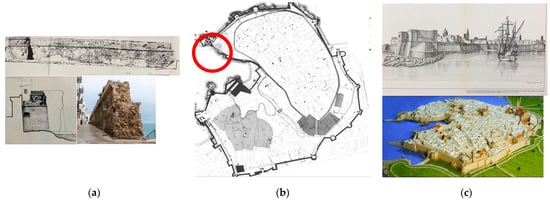
Figure 3.
(a) The survey, section and view of the walls of the old gate, (b) the study on the construction phases of the walls (Capitanio D.) and (c) the iconography and model of the walls of Monopoli.
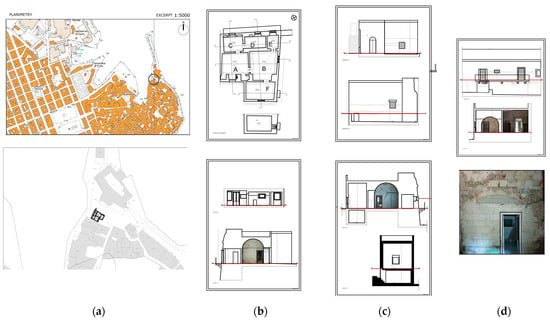
Figure 4.
(a) The urban framework; (b) the plan and sections; (c) the elevations of piazza castello and sections and (d) the elevation of the port and internal sections.

Figure 5.
(a) The morphological typological analysis of the walls of rooms A–B; (b) the morphological typological analysis of the walls of rooms B–E; (c) the morphological typological analysis of the walls of rooms C–E in conjunction with comparison of the 1947 cadastre and (d) the 3D relief of the wall block.
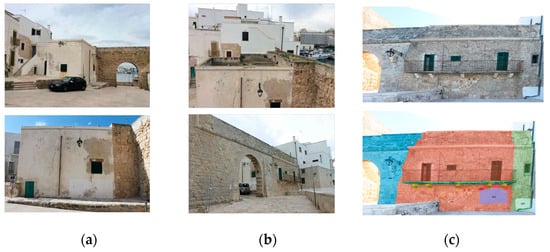
Figure 6.
(a) The elevations of piazza castello; (b) the elevations of piazza castello and port and (c) the elevation on the sea and stratigraphic analysis of the facade.
5. The Sages
In respect of the light of data emerging from the stratigraphic investigation, it was deemed appropriate to proceed with investigations that were focused on the foundation walls in order to identify the geometric and construction characteristics of the seabed system, as well as to recognize the morphological and typological characteristics of the infill of US2–US3, which face the sea. After removing the screed from rooms A and B, we found fill underneath. The first test carried out in room (A) at the entrance to room (C) highlighted the internal mouth of the cannon position that was filled with earth in the sixteenth-century wall. The second test carried out in room (B), in correspondence with the window on the front of the castle, highlighted a section of wall with different construction characteristics from the previous one. Other investigations were carried out on the ancient wall both on the roof and inside, thereby confirming the hypotheses that emerged from the historical investigation regarding the presence of the nucleus within the Renaissance masonry. Following the modification in progress that was approved by the competent Superintendency (MIBAC-SABAP-BA N.0000466 of 17 January 2017), the excavation of the basement was authorized. The excavation was aimed at, on the one hand, creating a new use environment and, on the other hand, to estimate the vulnerability of the masonry structures. The estimation of vulnerability in ancient centers is currently one of the most interesting topics in the field of seismic prevention, especially with a view to outlining possible damage scenarios and defining strategies and priorities for the purposes of intervention in respect to the artifacts [15]. The reconstruction of the transformation phases of the underground rooms was considered essential in order to verify whether the increases and the morpho-typological characteristics of the same could have introduced weaknesses to the wall structure of the entire building (Figure 7).
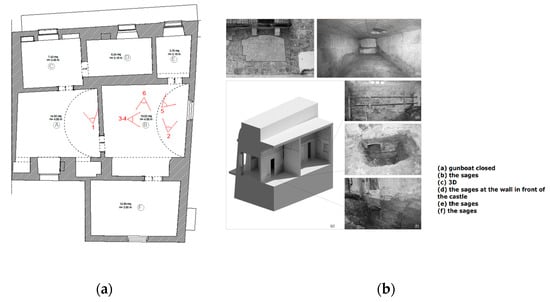
Figure 7.
(a) A plan showing the views of the essays and (b) the essays and 3D rendering of the blocks of the ancient walls.
6. The Project
Following the discovery of the sixteenth-century gunboat and the underground structures, the house was declared of cultural interest by the competent Superintendency (legislative decree n.42 of 2004). This has allowed the property to access funding that is dedicated to the protection and conservation of historical assets. The intervention, aimed at reversibility, recognition and compatibility, involves two distinct levels—the ground floor and the basement. After bringing to light the ancient masonry of the base, the construction of horizontal and connecting structures between the two levels is envisaged, as well as the pursuit of the reversibility criteria, which are derived via the use of dry technologies. The dividing deck between the two levels will be constructed of a light structure of steel beams with wooden planks. Further, the screeds will be constructed of expanded clay granules and fiber-reinforced gypsum slabs. The system of vertical connectives between the different levels will be found in light structures. Rooms A, B and F of the ground floor will be divided by light prefabricated walls. Moreover, a skylight was provided in the entrance of the building, for the purposes of a visual use of the gunboat below. The dividing wall between rooms A and C will be demolished in order to naturally illuminate room A, instead of it being in the dark as it currently stands. The small rooms within the thickness of the ancient wall will have two views of the port in order to replace the old balcony that hid the view of the cannon position. The internal and external finishes, with the exception of the ancient wall on the port, involve the use of slaked lime plaster, mineral aggregates and white lime painting. The fixtures will be constructed of wood and the external facades will be affected by a conservative restoration [16] (Figure 8).
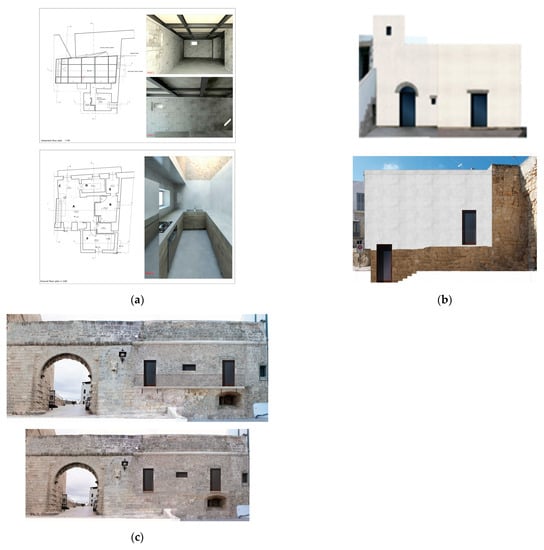
Figure 8.
(a) A plan rendering the CDE rooms and panta of the mezzanine with a rendering of the underground; (b) the elevations of the piazza castello and (c) the first hypothesis regarding the sea elevation with the balcony, as well as the sea elevation that will be the case when the restoration work is complete.
7. The Restoration Site
7.1. The Excavation
The excavation of the underground area involved a deposit of approximately 35 square meters of landfill with heterogeneous stratigraphy. Once the excavation is complete, it is expected that the room will be used with a final height of 2.45 m. Regarding the first diaries, it is believed that the backfilling was carried out with a systematic activity that can be referred to the period of 1811–1866. The construction site is in progress with all the preparatory precautions for the condition of safety and management feasibility (i.e., scaffolding, scaffolding, etc.). This is in conjunction with the garrison functions that are aimed at ensuring the temporary stability of the structure. Provisional arches were constructed in order to support the roofs of the upper rooms. The removal of the backfill, manually, is underway for small stretches and highlights the following: the ceramic and stylistic finds attributed to early medieval phases with certain elements, which date back to the 16th century; as well as stretches of masonry from different eras, i.e., the mouth of an ancient cistern and an important criticality regarding the foundation system.
7.2. The Reconstruction of the Transformation Phases: Morpho-Typological and Stratigraphic Analysis
The masonry sections brought to light, with the removal of the backfill, the present constructive and conservative features of a different nature. Below follows an analysis of the wall sections: Wall section (1) from the 16th century possesses the internal mouth of the gunboat and is found below the rooms (C, D and E). In addition, it is characterized by large stone blocks that are set with horizontal rows that possess regular ashlar dimensions in a good condition. Further, it rests on a wall section composed of large stone blocks that can be traced to the walls of the Messapian age, which also shows coherent construction characteristics; masonry section (2) from the 18th century, below the perimeter wall of the room (B) is characterized by stone blocks that are laid out with sub-horizontal rows and an irregular dimension in respect of the ashlars. These ashlars exist in the lower part of the house and is more regular in the upper one, which is in a fair state of conservation. Moreover, it can be deduced that it was affected by two superimposed construction sites. The wall leans against the wall (1) without any type of connection or corner; masonry section (3) is characterized by the stone moldings of the unloading arches of the upper room and by an infill that connects room B to the internal room F. The plinths are placed on incoherent material (i.e., blocks of stone and earth) and show an important structural criticality that is linked to the lack of a coherent foundation plane in respect of the punctual drainage systems of the vaults; the wall sections (4), on the other hand, do not belong to the foundation system. They are located in the central area of the backfill, thereby showing similar constructive characteristics. Following a direct observation, they can be referred to a 60 cm thick wall with irregular ashlars in hard stone and a core with earth and stone flakes. In reference to structures in the castle garden, it can be demonstrated that they were recovered from rooms of a previous age. The most reliable hypothesis is that they could be part of an environment that was dedicated to housing the cannon. In support of this notion, the wall texture appears to be medieval-age structures. The different morpho-typological characteristics of the foundation walls, the lack of joints and the support of the plinths of the upper roofs on incoherent material have led to different observations. The excavation, initially aimed at highlighting the position of the 16th century cannon, led to the recognition of these foundation problems (Figure 9).

Figure 9.
(a) The wall section (1) from the 16th century; (b) the wall section (2) from the 18th century; (c) the wall section (3), which possesses critical issues in respect of the foundations and (d) the wall section (4) that can be traced to medieval structures.
7.3. The Construction Site under the Walls
At the same time as the excavation, the construction site of the sub-foundations is also commencing. The execution of the sub-masonry will be carried out in conjunction with the small construction sites. Each construction site involves the removal of earthy material up to the level deemed appropriate for the positioning of the crawl space, where the following actions will be taken: the construction of a leveling base in reinforced concrete; the construction of squared stone masonry for the remaining part to be set as flush with the upper one; and the bonding of the new walls with the existing ones. The regeneration of the core walls that are affected by the interventions via the injections of hydraulic lime are for a height to be established that starts from the current level 0. Conducting this process properly will be fundamental in respect of uniting all the small construction sites.
7.4. The Construction Site of the External Walls
Following the removal of the deteriorated plaster, we restored the wall texture through the “unstitch and cu-ci” method. The replacement of the material was carried out with the use of material found on the site using the same as a “quarry”. Subsequently, following the anti-salt treatment, the plasters with cycles of NHL 3.5 hydraulic lime were used with compatible finishes in potassium silicate. In respect of the restoration of the ancient wall that faces the sea, in the first analysis a cleaning was carried out, as well as the removal from the surface of any type of incoherent deposit, especially those that contributed to the deterioration of the material. The removal method mainly favored dry cleaning with compresses in the case of resistant crusts and, in any case, thus avoiding wetting the curtain as much as possible in consideration of the existing conditions of marine aerosol and salts that are contained in the porosity of the material, the sealing of joints with pointing that are based on lime mortar, as well as the aggregates of the same color as the stone. The grouting and sealing of joints with hydraulic lime mortar entails the brushing and final sponging process. Furthermore, after the balcony was removed we proceeded with the opening of the cannon and its subsequent restoration. This was achieved by: cleaning the loose material; washing and repositioning the partially torn ashlars; sealing and patching up of the lesions present both in the extradossal and intradossal parts (with the flakes of suitable material found at the excavation site); the use of natural hydraulic lime mortar; a compensation for deficiencies; and the application of cortical consolidating fixative (Figure 10 and Figure 11).
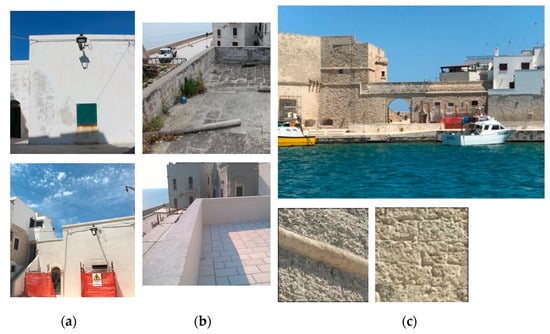
Figure 10.
Restoration interventions: (a) the piazza castello elevations; (b) the roof and (c) the port elevation.

Figure 11.
The restoration position of the cannon: (a) the opening; (b) the balcony props; (c) the mending gaps and (d) the completed intervention.
8. Conclusions
This contribution focuses on the reuse of ancient urban masonry structures for residential use. Different studies on the urban landscape of Monopoli documented that between the nineteenth and twentieth centuries, this was a consolidated practice. The current, residential use of the house within the walls of Monopoli, however, appears singular in the urban context. The reasons for this are strongly connected to the long period of abandonment that the house experienced and to its proximity to the castle, which in some way contained its transformation and growth actions. How many other harborside houses could reveal the remains of the ancient city within? If recovered with an adequate restoration, it is reasonable to conclude that these houses still contain “planning documents of the past”. Another theme addressed in this contribution is that of the vulnerability of foundations. In the 2022 Report of Goal 11 of AsviS [17] it is stated that “Sustainable cities and communities—Make cities and human settlements inclusive, safe, durable and sustainable”. The vulnerability of historic buildings is therefore an important topic raised in this paper. In our case study, the preliminary discovery of the underground room with the fifteenth-century gunboat prepared the design intervention aimed at recovering the underground environment, both from the point of view of historical-cultural value, and from a technical-structural point of view. In the European context, reference is made to the design interventions of Paredes and Pedrosa (Madrid) with the following cases: the houses of Oropesa (Toledo) incorporated into the fourteenth-century walls; and the Ceuta Library in North Africa, where the underground archaeological area is visible on three levels. The library is recognizable in its archaeological history and traces the “cultural documents of the city”—which in our study were identified thanks to the preliminary historical-constructive investigations and the desire to carry out a protection and conservation project aimed at proposing a sustainable management of the city wall. In Italy, the proposal of the National Association for the protection of the historical, artistic and natural heritage of the nation is recent, which on the occasion of the European Heritage Days (GEP2022) of September 2022, organized a campaign and a conference on the theme of cities “to draw up” a “Charter of the Walls”. The decision to dedicate a reflection to this theme was born from the recognition of the criticality of this cultural heritage. The objective of the “Charter of the Walls” is to arrive at the drafting of recommendations in order to promote the sustainability and protection of this heritage, through the comparison between the various Italian institutions and the debate with the experts. Various reflections arose from the conference, among which it is believed that, where necessary, “the declaration of public interest must be provided. The constraints therefore represent an opportunity, not a limitation to the right of ownership: the State recognizes the funding against the declaration of public interest, this facilitates the conservation of the protected asset and increases its value. Cultural heritage is therefore a “common good”. In fact, in the “Convention on the value of cultural heritage for society” (Convention of Faro), signed in 2005, the strong link with the identity of the places was recognized to the cultural heritage and, consequently, its fruition can only improve the quality of life and well-being of residents and visitors. In the Management of World Cultural Heritage (2019) of ICCROM (Italian Heritage World Heritage Association) it is also clear that the company should participate in the management of cultural heritage through management systems and plans aimed at the long-term strategic protection of the sites of our heritage. It should also be remembered that the current Italian technical standards for the structural recovery of historic buildings (par. 8.5.4 NTC 2018, par. C8.5.4 of Circular 21/01/2019 n. 7, par. 4.1 DPCM 09/02/2011)—which are in continuity with the previous ones—confirmed the obligation to reach a higher level of knowledge. Furthermore, this must not be limited to diagnostic tests alone, but also in compliance with the archival research of historical projects and drawings from which to deduce the historical construction phases of the artefacts. In conclusion, making the management of the cultural heritage of the urban walls of our cities sustainable can only be realistic through a management plan for this heritage which primarily includes an “architectural and archaeological protection constraint”. Subsequently, the guardianship body should prepare a cognitive plan for the purposes of the recovery projects aimed at the recognition of the walls and the houses within the walls, as “cultural documents of the city”. The level of knowledge of minor historical finds is possible only through an appropriate methodology and practice of field research which is carried out with: archaeological investigations; surveys on landscape archeology; and investigations typical of architectural restoration as in our case study. From here we can also identify the risks associated with natural disasters and consequently we can establish the processes necessary to mitigate the risk. The houses within the walls bound and restored with an adequate methodology contain an intrinsic economic value in continuous expansion over time directly connected not only to the arrest of the patrimonial degradation, but also to the satisfaction of the growing cultural and tourist needs of the community in relation to conscious usability (pedestrian or cycle/pedestrian connections). However, it is essential to develop cooperation between the public and private sectors for effective management of cultural heritage in order to produce positive and meaningful actions for both sectors. The public sector must offer rules and opportunities for the sustainability of the city walls.
Funding
This research received no external funding.
Institutional Review Board Statement
Not applicable.
Informed Consent Statement
Not applicable.
Data Availability Statement
Not applicable.
Acknowledgments
The author, i.e., the scientific director of the restoration project, wishes to thank: the architect Natalia D’Amco; Fabio Fatiguso (Bari Polytechnic); the engineer D. Colapietro and the architect D. Domenico Capitanio. A special thanks is also directed to the owner of the house, Annarita Galanto.
Conflicts of Interest
The author declares no conflict of interest.
References
- Legislative Decree 22 January 2004, n. 42, Code of Cultural Heritage and Landscape Published in the Official Gazette of the Italian Republic No. 45 of 24 February 2004. It Entered into Force on 1 May 2004. Available online: https://leap.unep.org/countries/it/national-legislation/legislative-decree-22-january-2004-n-42-code-cultural-and (accessed on 10 December 2022).
- DettagliCategoria Principale: Beni CulturaliCategoria: DottrinaPubblicato: 30 Novembre -0001Visite: 16745. L’assenza di una Definizione Legislativa di “Centro Storico”. Ruggiero Marzocca. Available online: https://lexambiente.it/materie/beni-culturali/171-dottrina171/1774-Beni%20culturali.%20Centri%20storici.html (accessed on 10 December 2022).
- Pane, R. Historical Center and Ancient Center in AA.VV; The Ancient Center of Naples: Naples, Italy, 1971; Volume I, p. 15. [Google Scholar]
- Diceglie, A. The cathedrals on the sea of Puglia. In Proceedings of the International Congress VIII Centenary Cathedral of Burgos, “El mundo de las Catedrales”, Burgos, Spain, 13–16 June 2022; pp. 493–499. [Google Scholar]
- Carocci, C.; Macca, V. Buildings’ Masonry Work: Construction Quality and Seismic Damage after 2016 Italy Earthquake. In Proceedings of the HERITAGE 2020—7th International Conference on Heritage and Sustainable, Development, Coimbra, Portugal, 8–10 July 2020; pp. 481–490. [Google Scholar]
- Capalbo, A. Finalborgo, Housing Phenomena in the Transformation of City Walls. Master’s Thesis, Architecture for the Restoration and Enhancement of Heritage, Polytechnic University of Milan, Milan, Italy, 2020. [Google Scholar]
- Diceglie, A. Conservation problems of archaeological structures subject to humidity variations. The Case Study of the castle of Santo Stefano. In Proceedings of the First International Scientific Conference “The Colors of Restoration”, Nardini Editore, Catania, Italia, 18–19 October 2021; pp. 475–489, in press. [Google Scholar]
- Diceglie, A. The Castle of Santo Stefano in Monopoli in Puglia; Archeology for Architecture, Gangemi: Rome, Italy, 2018; pp. 9–11. [Google Scholar]
- Carrieri, M. Monopoli (Bari), Church of San Pietro. In Taras; Scorpione Ed.: Taranto, Italy, 1989; pp. 254–255. [Google Scholar]
- Capitanio, D. The defensive system and the city. In Monopoli in Its Past; Prospero Rendella Municipal Library: Monopoli, Italy, 1991; Volume 5, pp. 11–84. [Google Scholar]
- Cinquepalmi, A. Historic Center (Monopoli, Bari), in Documents from the Bronze Age, Investigations along the Apulian Adriatic Side; Ministry of Cultural and Environmental Heritage, Archaeological Superintendency of Puglia, National Museum of Egnazia: Fasano, Italy, 1998; pp. 101–103. [Google Scholar]
- Carrieri, M. Monopoli (Bari), Duomo. In Taras; Scorpione Ed.: Taranto, Italy, 1987; pp. 175–177, (in particular p. 176). [Google Scholar]
- Barletta, M.; Papio, A.; Rotondo, S. Historical-Critical Contribution to a Systematic Study on the Transformations of the Castle of Monopoli, Extract from Monopoli in Its Past; N.5; Prospero Rendella Municipal Library: Monopoli, Italy, 1991. [Google Scholar]
- Lillo, S.A.C.M. Municipal Archive of Monopoli, File 673, Category X, Public Works: Map a part of the Municipality of Monopoli with an indication of the works proposed for the formation of the port (Ing. Lamberti, 1866). In Monopoli Sintesi Storico Geografica; Officine Grafiche Colucci: Monopoli, Italy, 1976. [Google Scholar]
- Stima della Vulnerabilità Sismica dei Centri Urbani: Il Caso di Forlì. Available online: https://www.ingenio-web.it/articoli/stima-della-vulnerabilita-sismica-dei-centri-urbani-il-caso-di-forli/ (accessed on 15 November 2022).
- Diceglie, A.; D’Amico, N. The restoration site of a house in Monopoli, Largo Castello, N. 5. In Proceedings of the 3rd International Conference on Conservation, Maintenance and Rehab, Braga, Portugal, 14–16 June 2017; June, Barcelos: Green Lines Instituto para o Desenvolvimento Sustentável/Green Lines Institute for Sustainable Development: Barcelos, Portugal, 2017; pp. 223–231. [Google Scholar]
- Italian Alliance for Sustainable Development Born in 2016 in Order to Increase the Importance of the 2023 Agenda. Available online: https://asvis.it/asvis-italian-alliance-for-sustainable-development (accessed on 10 December 2022).
Disclaimer/Publisher’s Note: The statements, opinions and data contained in all publications are solely those of the individual author(s) and contributor(s) and not of MDPI and/or the editor(s). MDPI and/or the editor(s) disclaim responsibility for any injury to people or property resulting from any ideas, methods, instructions or products referred to in the content. |
© 2023 by the author. Licensee MDPI, Basel, Switzerland. This article is an open access article distributed under the terms and conditions of the Creative Commons Attribution (CC BY) license (https://creativecommons.org/licenses/by/4.0/).